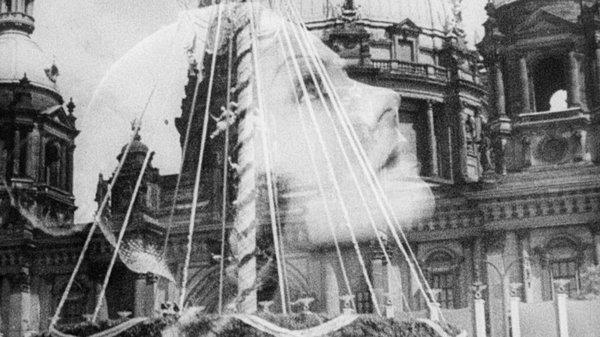When we discuss Nazi propaganda films, we usually talk about only two: Leni Riefenstahl’s Olympia and Triumph of the Will. Those films are recognizably propaganda—supposed documentaries meant to showcase the power and pomp of Germany under the Nazis. Riefenstahl’s work has become the only mode by which many American and European critics study Nazi propaganda. We often forget that Germany continued to produce a multitude of films under the Nazi regime and well into World War II, taking over studios and film production until only Ufa remained, a state-run apparatus that made everything from musicals and comedies to prestige costume dramas, melodramas, and even wartime romances. The German public did not sit around watching Triumph of the Will on a continuous loop but saw films that bear a striking resemblance to contemporary Hollywood productions, with big stars and flashy production values meant to reinforce a narrative of Aryan power. Director Rüdiger Suchsland’s fascinating documentary Hitler’s Hollywood goes into detail about the films made during Hitler’s rise to power, investigating German cinema itself as a force of propaganda.

Suchsland’s argument stems from the work of Siegfried Kracauer, a German intellectual and film theorist who wrote numerous essays and books, including From Caligari to Hitler, an investigation into Weimar cinema. The essence of Kracauer’s argument was that cinema can reveal the psychological status of a society, and that understanding the cinema produced by a culture and time period reveals information about the character of the society that produced it. While Kracauer covered the cinema in the years that led up to Hitler’s rise to power, Hitler’s Hollywood takes it further, looking into Nazi-produced film itself. The documentary details the changes in German cinema as the country went from economic depression to war and eventual defeat; it covers a broad scope of films in copious clips and montages, and includes some of the history of the directors, writers, and actors who appeared in the films (including a very young Ingrid Bergman). To its credit, it doesn’t only cover blatantly anti-Semitic works like Jew Suss, but the whole spectrum of films and their undercurrents. The documentary is narrated, sometimes inexplicably, by Udo Kier, who details the history of some of the films and the general regulations that governed German film production under the Nazis.
The strength of Hitler’s Hollywood is in its showcasing of a wide spectrum of films, many of which are rarely seen or unavailable otherwise. There are melodramas and romances, costume dramas of the French Revolution, lavish color musicals, attempts at social realism, detective stories, and coming-of-age narratives. The techniques borrow heavily from earlier German cinema, including the Expressionism so prevalent in Weimar, and from the Hollywood productions of the same period. One tap-dancing sequence eerily recalls some of the Astaire/Rogers films, and a melodrama uses overlapping frames to create a sense of hallucination similar to Fritz Lang’s work (Lang himself left Germany in 1933). Some of the films would not have appeared out of place in an American cinema in 1939. Jew Suss, for instance, is a vile film, but its vileness is founded in how distressingly familiar it all looks to anyone who has seen a classical Hollywood film. It bears a striking resemblance to The Count of Monte Cristo or The Mark of Zorro in appearance and subject. It’s a costume melodrama, with a mustache-twirling villain, threatened lovers, daring swordfights, and romantic rescues. And it is shockingly anti-Semitic; so much so that the director was one of the few to be brought up on war crimes charges for his part in it.
The documentary argues that beneath the smiling faces is hysteria, an active desire for death, and a mythologizing of the German people and the Third Reich itself. The issue with Hitler’s Hollywood, though, is that it does not seem to spend enough time actually dissecting the films it’s discussing. The voiceover informs the viewer of the history and the meaning of the films, but there are no scene analyses, no fragmentation of the narrative to form an argument. The film essentially asks the viewer to take these conclusions at face value—and while the arguments certainly make sense, they would be better supported if the viewer got to see them in action. This would be less of a problem if the films were otherwise well-known, but the vast majority of them are (unsurprisingly) unseen outside of film classrooms. Anyone without a combined knowledge of Weimar cinema and Hollywood of the 30s and 40s might have a difficult time drawing connections.
That being said, Hitler’s Hollywood is an essential critical work, not least because it shows just how apparently safe propaganda appears. These films are selling an ideology but watching the clips and hearing the arguments about them drives home the fact that they are not so different, on the surface, as other films from the same period. This is a documentary about film as a force to convey meaning, about the need, even, of critical consideration of even the most apparently banal pieces of entertainment. What is being sold? How is it being sold? And what does that tell us about the culture that produced it? Scrutinizing films made by the state and sold as state propaganda can perhaps tell us something about how to scrutinize our own films, and what they sell, mean, and say about our culture.
Hitler’s Hollywood is available to stream on Kanopy, and to rent on YouTube. It is required viewing for any film critic.
